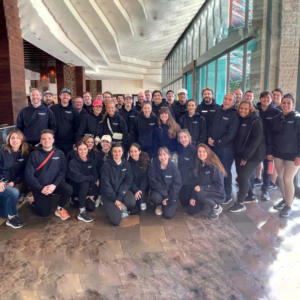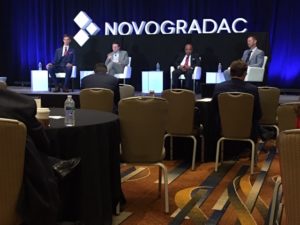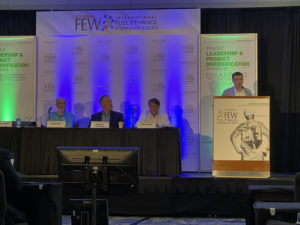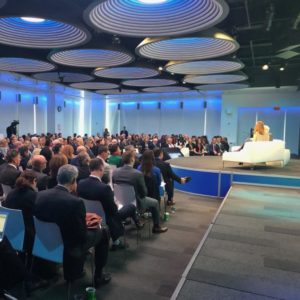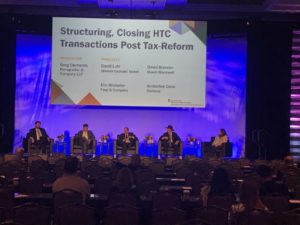News
As Foss & Company reaches its 40th year in business, the company celebrates not only its longevity, but its commitment to excellence, a driving force behind its success. From its inception to the present day, Foss & Company has overcome challenges and pioneered solutions to become a leading organization in the tax credit space. This success can be attributed to its resilience, adaptability to the marketplace and commitment to providing exceptional services to its institutional investor and developer clients. The company’s adaptability has been key to its survival and growth in tax credit space. Starting out, Foss & Company acted primarily as a broker, connecting institutional investors to developers. However, now the company manages almost 95% of its investments through its investment funds, adding tremendous value to investors. This is made possible by our dedicated acquisitions and underwriting teams and asset managers who carefully evaluate projects using market research, capital structure, performance history, budgets, and more. Projects brought into our funds undergo rigorous due diligence through our in-house experts, external consultants, and third-party certifications. Our asset management team oversees projects once added to a fund and provides extensive reporting services, monitoring each project through deal exit. This evolution in investment strategy reflects Foss & Company’s ability to pivot and adapt to market changes while staying true to its mission of creating value for institutional investors and developers alike. The company’s agility and dynamic approach combined with tremendous institutional knowledge are what truly make Foss & Company stand out. Encouraging an entrepreneurial and solution-oriented workplace, Foss & Company has more flexibility to identify gaps in the marketplace, coming up with creative solutions and product offerings that lead to more opportunities for engagement. Some examples of this have included creating State Tax Credit Funds for our investors that have a more drilled…
Read MoreFoss & Company is comprised of a group of experienced professionals, representing the best in class within their respective fields. In this blog series, we highlight different Foss & Company team members to shine a light on the diverse and dedicated people that help make us who we are. Bryen Alperin joined Foss & Company in November of 2017. As Managing Director, Bryen leads all aspects of the investment, origination, and asset management process for renewable energy and sustainability funds. Prior to joining Foss & Company, he worked in commercial banking and led debt financing for a broad range of middle market businesses and commercial projects. Bryen earned his BA in Economics and graduated magna cum laude from the University of California, Davis. He has an Executive Certification in Sustainable Capitalism & ESG from the University of California, Berkeley. He is based out of our Denver office. Get to know Bryen in the latest Spotlight Series Blog: How did you get started in renewable energy and sustainability tax credit industry? Prior to joining Foss & Co., I was a commercial underwriter at a community development bank. During that time, I was often tasked with underwriting our largest and most complex loans. I became the subject matter expert on loans to renewable energy projects, as well as low-income-housing projects and various other impact oriented products. While I enjoyed commercial banking, I was excited to join Foss & Co. so that I could spend more of my time focused on impact projects. I initially joined Foss & Co. as an investment manager for our real estate division, then transitioned to renewable energy to help expand our renewable energy and sustainable technologies division in Denver. What interested you about tax credits? The government tends to offer tax credits to incentivize projects that have a…
Read MoreBY BRYEN ALPERIN, DIRECTOR OF RENEWABLE ENERGY AND SUSTAINABLE TECHNOLOGIES A March 21 meeting of the Securities and Exchange Commission (SEC) proposed a reporting framework for publicly traded companies to provide information about the carbon intensity of their businesses. Voluntary disclosure of climate risk factors has already become widespread in recent years, with the SEC estimating that about one third of regulatory filings submitted by public companies in 2019 and 2020 included some degree of environmental impact assessment. Standardizing these disclosures will make them more functional for investors as “consistent, comparable, and reliable information” on climate-related risk exposure, says the SEC’s recent guidance. Carbon accounting, the process by which emissions are calculated and attributed, has evolved in recent years thanks to work by the World Resources Institute and the World Business Council for Sustainable Development. Their joint Greenhouse Gas Protocol lays out three principal areas of emissions: Scope 1: Direct Emissions Scope 1 emissions result directly from business activities, such as fuel used in vehicles owned by the company and exhaust from running manufacturing equipment. This is the simplest scope of emissions to calculate and would be required of all publicly traded companies under the proposed rule change. One option for reducing your Scope 1 emissions are carbon offsets. Example carbon offsets you can purchase include forest preservation, energy efficiency projects, or carbon capture. There are a variety of brokers which sell carbon offsets, but since the market is largely unregulated, it’s important you work with an expert advisor to perform due diligence on your purchase. Tax Credit Use Case: The recently improved 45Q Sequestration Tax Credit is a tax credit for carbon capture and sequestration. Projects which generate 45Q tax credits may also produce carbon offsets, and tax credit investors may be able to gain access to carbon offsets…
Read MoreFoss & Company is comprised of a group of experienced professionals, representing the best in class within their respective fields. In this blog series, we highlight different Foss & Company team members to shine a light on the diverse and dedicated people that help make us who we are. Next in the series is Jack Mans, Foss & Company Partner and Chief Financial Officer. How did you get started in this industry? I ended up here because I needed a job. I quit my former job and moved cross country in 2012. After growing up around the Jersey shore, it was time for a change, and I choose the Golden State. I had a family safety net living in the East Bay to help the transition, so I took that opportunity and packed my car for the cross-country trip. I really knew very little about the tax credit world at the time, but as a practicing CPA, I had a client who once qualified for HTCs from properties in New York City and Maine, so I had some surface level knowledge. I arrived in San Francisco in 2012 looking for a new job and met George Barry. I started the Monday following that meeting and the rest is history. What interested you about this industry? Seeing old, abandoned buildings and eye sores of many cities and communities converted into thriving places is truly amazing. There is a tremendous economic impact these tax credit programs offer. There’s a reason the federal and state governments create these programs and provide these incentives! When did you join and what interested you about Foss & Company? I joined in 2012 after my move to California and just as the Giants secured their 2ndWorld series win of the previous 3 years (fun timing!). …
Read MoreBY JOHN SOREL, AQUISITIONS Last week I was pleased to attend the 2021 Novogradac Historic Tax Credit Conference in Chicago. While I attended live and in person, the event was a hybrid show with virtual attendance which was due to the fact that neither business travel policies or pre-pandemic comfort levels have returned to “normal.” While the live audience was perhaps a little smaller and the cocktail reception less well attended than in other years, the conference was a success in my view. This is particularly true given that it was one of the first in-person events to take place as we all begin to emerge from the COVID-19 required distancing protocols. I had the pleasure of participating on the “Building the Capital Stack” panel discussion which focused on the challenges of combining federal and state historic tax credits with other funding sources, particularly with the use of Opportunity Zone investment. We discussed that while it can be challenging layering multiple funding sources, the benefits generally outweigh the difficulties and much of the challenge is simply understanding the various programs and anticipating everyone’s pain points. Our panel was moderated by Novogradac’s George Barlow and I was joined on the stage by fellow panelists Irvin Henderson of Henderson Company, Shawn Whitney of law firm of Spencer Fane LLP and Melissa McCormack of Bank of America. As for the show at-large, there was Lots of discussion about the possibility of an increase in the federal credit amount from 20% to 30%. Unfortunately, we still have more questions than answers there. Although this conference was smaller than those in the past, Novogradac were terrific hosts, the Swiss Hotel did a wonderful job and I welcomed the opportunity to meet face to face with a number of important clients and counter-parties. It’s just…
Read MoreNext in the series is John Bowman, Foss & Company partner and acquisitions team members. I am a lawyer by training and practiced law for 10 years. It was not for me. I went to work for a friend of mine at a small LIHTC syndication shop in Montgomery, AL – my home town. After about 3 months on the job, we had a developer client that had an Art Deco building in Birmingham, AL, which had HTCs. They looked at me and said, “you are the new guy, go figure out to syndicate these credits.” I did just that and the rest is history. My father was a lawyer and a real estate developer so I have been around real estate all of my life. He and I were even in the same law firm. My father and his law partners bought and restored the Winter Building in Montgomery in the late 70’s. I would go downtown with him on Saturdays to inspect the work. It was incredible. The building is on the National Register with parts of the building having been constructed by skilled masons that were slaves. (1845 construction) The building housed the Confederate telegraph office. The telegram to Fort Sumter that started the Civil War was sent from that office. I was hooked on old buildings! Since this was pre-1986, he and his partners used the historic tax credits to offset their personal income. I joined Foss & Company in 2014. I was part of the Chevron team at my previous job and when Chevron shut down the HTC department, I was out of a job. I knew George Barry from the Chevron meetings as well as being a competitor. My first call after being let go was to Alan Levine – President…
Read MoreBY BRYEN ALPERIN, DIRECTOR OF RENEWABLE ENERGY & SUSTAINABLE TECHNOLOGIES I certainly don’t know all there is to know about ethanol. Prior to the 45Q tax credit, I knew exactly two things about ethanol: it is a sustainable fuel source, and it is typically made from corn. I recently attended the 2021 Fuel Ethanol Workshop and Expo in Des Moines, Iowa, to speak on a panel about carbon capture, 45Q and the impact these will have on the ethanol industry. The panel, moderated by John Pierce of Perkins Coie LLP, was well attended and led to engaging conversations. While I was there, I learned quite a bit about the industry. Here are five things I learned pertaining to carbon capture in the ethanol industry: Carbon Capture and Sequestration (CCS)Development for Ethanol Plants is Already Underway Christianson Biofuels Benchmarking statistics indicated that over 50% of ethanol plants in the US are in some stage of development for a CO2 capture or sequestration project. Given that the larger projects are the ones most likely to be considering CCS, I expect this figure would be higher if weighted for ethanol production volume. The US produced approximately 13.8 billion gallons of ethanol in 2020, which would equate to approximately 41.4 million tons of CO2 capture potential pear year. This means there are $25 billion of 45Q tax credits that could be generated in the ethanol industry alone (assuming a $50 tax credit and a 12-year credit period.) If a significant percentage of these projects end up getting developed, the volume of tax credits could be staggering. LCFS Fuel Credit Invalidation Needs to be Addressed for CCS The Low Carbon Fuel Standard (LCFS) overseen by the California Air Resources Board allows CCS projects to reduce emissions associated with the production of transport fuels sold in California and generate…
Read MoreNext in the series is Director of Acquisitions, Eric Brubaker. I was a senior in college, I had just returned from Spring Break in Jamaica where I had spent the last of my savings. With two months left in the Spring semester, I needed to find a job and make money. We always had a lot of guest speakers at my college who would come in and create a case study for us to analyze/review/debate about their particular industry. As it just so happened, Jeff Jacobson of Foss & Company was a guest speaker in my class in March of 2005. I was somewhat interested in his presentation, but what really got my attention was his announcement at the end of his presentation that he was looking to hire an intern. I was so excited I almost tackled him when the class was over and thankfully he chose to hire me. Within my first week I had agreed to a deal in principal with a young developer for a project called the Colonial Arms Building in Roanoke, VA, and shortly thereafter I informed Jeff that I would be sticking around full time. I was fortunate that Virginia was my first territory and there were so many exciting things going on in the VA HTC space at that time. There were a lot of opportunities, lots of smart, hardworking and visionary developers, the projects were interesting, and this was the time that “living downtown” was just becoming a thing. Yes, “living downtown” in cities such as San Francisco, Chicago, NYC, etc., had been going on for 100+ years, but back in 2005 when I worked on the Colonial Arms Building there were only 98 residential units in downtown Roanoke. Not only was it was fun to be part of this…
Read MoreThe former foundry has earned an award as a HTC Non-Residential Development that Best Exemplifies Major Community Impact This July, City Foundry STL was named the Historic Tax Credit (HTC) Non-Residential Development that Best Exemplifies Major Community Impact for the 2021 Novogradac Journal of Tax Credits Historic Rehabilitation Awards. City Foundry STL is one of the largest historic redevelopments in St. Louis, Missouri, history. The 300,000-square-foot office, retail and entertainment complex is anchored by a grocery store, a movie theater and a food hall featuring local chef-driven concepts. The development, designed by Lawrence Group and developed by New + Found, is on the site of the former Century Electric Foundry complex which was built in 1929 and operated as a working foundry until 2007. Prior to redevelopment, the nine-acre site was one of the largest brownfield sites in the St. Louis region. Foss & Company is proud to have served as both federal and state HTC investor on this project. City Foundry is providing much needed reinvigoration into the Midtown area and will serve as a place in the heart of the city to gather, eat, work and play – a new place to build a community in St. Louis. We would like to thank Novogradac for recognizing this project as an example of excellence in historic preservation that will benefit those on St. Louis and beyond. City Foundry STL and other winners of the Historic Rehabilitation Awards will be honored at the Novogradac 2021 Historic Tax Credit Conference, October 7-8 in Chicago. For more information on City Foundry STL and the merchants moving to the complex, visit www.cityfoundrystl.com.
Read MoreBY DREW GOLDMAN, VP OF INVESTMENTS Every year, many sophisticated corporations divert over $20 billion of federal tax payments into projects in renewable energy, affordable housing, and historic preservation, in exchange for tax breaks and investment benefits. Some perceive a significant level of complication in these programs, and therefore delay taking a closer look. The very word ‘investment’ moves many people outside their comfort zones. As a manager of funds delivering Renewable Energy Tax Credits (Sec. 48 of the Internal Revenue Code), Foss & Company is in the business of making it easy to take advantage of this high-impact federal tax incentive. ITC (investment tax credit) Funds provide a well-defined system for dealing with project and developer selection, project structuring, negotiation and closing, as well as potential tax benefit delivery including: Determining project eligibility and focusing on any hurdles to placing site(s) into service Structuring the transaction to address developer and investor needs Underwriting the developer, underlying power purchase contract and pro forma operations Valuing and appropriately pricing tax credits and other projected benefits Delivering Tax documents and financial reporting for annual federal filings In terms of physical asset protection, potential losses at a solar farm typically to fall into two categories: ‘Acts of God’– fire, floods, earthquakes, or storms that damage the array or interrupting operations; and ‘Acts of Man’ – such as terrorism, a vehicle or plane crash, negligent maintenance, or faulty equipment. These risks can be insured against potential losses. One risk typically not covered in conventional policies is fraud. Foss & Company conducts due diligence and background checks on each developer and its principals prior to closing any project. The lender and the long-term power buyer (typically a utility, municipality, or large corporation) conduct their own independent evaluations as well. Recapture Risk – The full value of…
Read MoreFoss & Company is comprised of a group of experienced professionals, representing the best in class within their respective fields. In a new blog series, we will be highlighting different Foss & Company team members to shine a light on the diverse and dedicated people that help make us who we are. Starting off this series with the president of Foss & Company – George Barry. How did you get started in this industry? Mostly by luck. After law school I knew following the huge footprints of my father in a career as a litigator was not for me. My wife had joined an Oil & Gas syndication firm a few years earlier and I had gotten to know the founder well. He offered me a position in the firm as a sales representative, much to the chagrin of my wife. This was in 1985 and our primary clients were high net worth individuals seeking to manage their tax liabilities in an environment where the top marginal rate was 70%. In less than a year the most significant changes to the tax code in 30 years occurred with the passage of the 1986 Tax Act. This completely blew up our former business model but it did, most fortunately, create the Low Income Tax Credit. We began marketing the LIHTC credits to individuals but soon realized this was better suited for institutional investors. We expanded our presence in the tax credit space to include solar (thermal, initially), landfill gas, refined coal, historic tax credits and more recently carbon capture production tax credits. What interested you about this industry? The tax credit industry is full of challenges. I enjoy getting up every day and taking on those challenges. I like that we can offer solutions to our partners, helping them convert a…
Read MoreOnce a niche investment approach thought to come at the expense of returns, ESG investing – strategies that align with a company’s Environmental, Social, and Governance values – has grown into a $30 trillion market as of 2019. Issues such as energy consumption, health and safety, diversity and inclusion, and effective board oversight are having a greater effect on the financial performance of companies – and investors have taken notice.One underutilized strategy that can enable companies to significantly boost their ESG performance is tax credit investment. By repurposing and redirecting a company’s estimated tax payments into qualified tax advantaged investments, companies can achieve triple bottom line results while fulfilling their ESG commitments. A tax credit is a government-sponsored tax incentive that can reduce a company’s tax liability dollar-for-dollar. The U.S. government uses tax credits to incentivize corporate taxpayers to invest in certain types of projects that produce economic, environmental, or social benefits. Federal and state governments offer tax credits to promote public/private partnerships, encouraging investment capital to flow to beneficial domestic programs, such as: • Affordable housing,• Historic preservation,• Sustainable energy,• And carbon sequestration. Investing in tax credits, which in turn benefit both the investor and the community at-large, is a clear and simpler avenue of providing investors a framework with which to evaluate investments. In a new white paper, Reuters Events and Foss & Company share best practices from Patagonia, Facebook, Harvard University, BNP Paribas and more. These examples outline why tax credit and ESG investments together have the potential to incorporate climate-positive and social-impact initiatives into a company’s investment and underwriting policy framework, aligning with their mission and values. To download the white paper, visit the Foss & Company Insights page.Questions? Contact Foss & Company today at [email protected].
Read MoreDuke developed a space that flattens the organization, creates spaces for thinking, for collaborating and for cross-pollinating ideas. Read more here: Duke Energy shows off new office at Optimist Hall – Charlotte Business Journal
Read MoreFoss & Co was pleased to attend and participate in the Bloomsberg Sustainable Business Summit this week. It was a great event.
Read MoreFoss & Company was a proud sponsor of Novogradac’s annual historic tax credit conference, which was held in Nashville, TN on September 26-28. During the conference, Foss & Company hosted an event for its partners and clients at the Listening Room Café, George Barry and Eric Brubaker attended a breakfast honoring Senator Cassidy’s support of the federal historic tax credit program, Foss team members participated on two panels………and managed to have some fun out and about on Broadway.
Read MoreGrowth continues in 2018 January 24, 2018, San Francisco CA – Foss and Company is pleased to announce that they closed out the 2017 calendar year having managed over $20 million in solar tax credit investments. The investments were made into seven unique projects that were all Massachusetts-based and approached 20 megawatts in scale. Foss Renewables Managing Director Alex Tiller said, “We were pleased with our 2017 results and are looking forward to investing over 10 times that amount in 2018 via our new renewable energy focused fund.” Tiller went on to say, “renewable energy investments are nothing new to this firm. Over our last 35 years we’ve managed over $500 million in renewable and alternative energy tax credit investments including some of the first large scale solar thermal SEGs projects in the Mojave Desert way back in the 1980’s. We’ve participated in landfill gas, refined coal and anaerobic digesters transactions as well. Foss and Company is a nationally recognized institutional investment management firm dedicated to providing corporate investors the greatest access to federal and state tax credit driven investments in the tax credit marketplace. Their services for solar developers include market pricing and transaction structuring, direct tax credit equity investments and private placement services. Additional information about the company is available at: fossandco.com
Read MoreLaunches Innovative Funding Platform for Solar Developers September 11, 2017, Las Vegas Nevada (Solar Power International trade show), San Francisco California: Foss & Company announces the launch of TaxEquity.com, a web platform designed to optimize the tax equity investment process for renewable energy developers. Arranging financing for commercial and industrial solar projects is notoriously challenging, and getting to a term sheet with a qualified tax equity investor that can close is arguably the most difficult part of assembling the capital stack. There are only a handful of highly active tax equity investors, and the whole process can often seem cumbersome and confusing due to high variability in each project, intricacies of tax code, deal structure and interests of debt providers. Because of this, a considerable amount of due diligence must be conducted on each project, driving up costs and resulting in a slow evaluation process. These factors set a relatively high barrier to entry for developers; most professional tax equity investors won’t work with developers with projects or portfolios less than 3 megawatts in size. Foss Renewable Energy Partners Managing Director Alex Tiller said “The goal with TaxEquity.com is to allow more capital to flow to more renewable energy projects. We can achieve this by standardizing the way we interface with developers and evaluate their projects. Additionally, we will work with debt providers to generate standardized and preapproved documents that a developer can choose to use, which leads to a streamlined evaluation process. Combining the two previous steps with algorithm driven analyses, we hope to cut the time to terms sheet down to hours, rather than days.” Tiller added that in the near future, they would like to find a way to fund projects as small as 100 kilowatts in size. Renewable energy project developers can evaluate the system on…
Read More